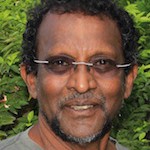A Brief Colonial History Of Ceylon(SriLanka)
Sri Lanka: One Island Two Nations
A Brief Colonial History Of Ceylon(SriLanka)
Sri Lanka: One Island Two Nations
(Full Story)
Search This Blog
Back to 500BC.
==========================
Thiranjala Weerasinghe sj.- One Island Two Nations
?????????????????????????????????????????????????Saturday, April 29, 2017
Toxic Dust

By Ranil Senanayake –April 28, 2017
Watching
the black oily sand that is being pumped from the ocean bottom off
Kerewalapitiya, is watching yet another tragedy unfolding due to the low
level of sensitivity to environmental factors by those who prepared the
SEIA. Perhaps they were too young to remember the Tsunami. The sludge
that came up with the wave of the Tsunami prompted the following
observation published in the press in 26/1/2005
“ The tsunami also produced many nasty surprises, such as the Return of our garbage over the last couple of centuries. Witnesses and survivors spoke of a ‘stinking black oily mud’ that accompanied the wave in many areas. The substance covered floors and tiles of houses after the event. There have been numerous reports of people getting sick from exposure to it via the flood or from just stepping in puddles of sludge. Sri Lanka is an island with a narrow but fairly flat offshore shelf that extends to the continental shelf. All the garbage, pollutants, toxins and topsoil that was dumped into the ocean combine with ship-based oil and organic pollutants to form lenses of toxic sludge on the flatter plains beyond the reefs. The force of wave creation, as the oncoming tsunami entered shallower waters, lifted this deposit into the oncoming wave.
The load of toxic sludge is now deposited on our shoreline mixed with the debris of the aftermath. Toxic marine sludge from other sites have been found to contain PCB’S, TBT’s, dioxins, heavy metals and chlorinated hydrocarbons – all chemicals that can damage human health and lead to cancers and other longer-term health effects. It is important that we do not dispose this debris back into the ocean nor put it in areas of human habitation.”
The
colour of the sediment that is being dumped in front of Colombo is
disturbing. It is reminiscent of the toxic sludge disturbed and brought
ashore by the Tsunami. The dredging of the bottom is being done
directly in the settling zone of all the pollutants discharged by the
city and the river. The tragedy is that the SEIA recognizes this fact
“Recorded
maximum concentration is 4mg/l at the dredging site which is far below
the recorded maximum ambient TSS levels during flood event of Kelani
River. Therefore, increase in suspended sediment level during dredging
operations is negligible and therefore no significant impact occurs
during dredging operations. The proposed sand dredging area, experiences
high turbidity conditions due to the discharges from Kelani River and
hence the existing organisms have higher tolerance level to high
turbidity levels.” (Chapter 7 pg. 1. SEIA)
By
this statement it is obvious that the dredging is going on in the zone
where the outflow from the city and the river settle. The SEIA lulls us
into a state of false security when it states that it is not a dynamic
zone, But, if this is not a dynamic zone where materials move all the
time, there will be much accumulation of sediment. It is amazing that
they did not consider the materials they would be dredging up with the
sand.
Perhaps they should have considered the studies done on the coastal zones of other places. The US Geological Survey report is an example:
They
point out that this zone “is impacted by many activities, such as
fishing, recreation, housing, sewage and waste disposal, shipping, and
preservation. In many cases, especially adjacent to major metropolitan
and agricultural areas, the sediments are polluted and the ecosystem has
suffered detrimental effects.”
In summary, the geochemical studies in a variety of coastal environments show that:
- Contaminants are widespread in coastal sediments. When remediation is needed, the large volume of impacted sediment presents a challenge. In many cases, the accumulations of the last hundred years of industrial and urban waste will continue to be reworked by biological and geological processes and thus remain accessible to biota well into the future.
- Urban centers and sites of past ocean disposal of wastes continue to be sources of contaminants to the coastal environment despite regulatory and practical advances in source reduction. Dated sediment cores provide a ruler with which to measure changes in many parameters over time.
- Databases of contaminant measurements in sediment that are assembled from diverse sources provide information about the spatial and temporal distribution of contaminants. Synthesis of regional data allows characterization of sediment quality, guidance in sampling strategies, determination of concentration ranges, identification of accumulation sites, indicators of recovery, and evidence of sediment dynamics.
- Patchy distribution of contaminants in sediments is associated with both source proximity and natural variations in sediment deposition and transport processes. Every region studied has locations of negligible contamination accumulation and other locations where high contaminant concentrations occur in “modern” sediment deposits that are tens of cm thick. The degree of uncertainty due to spatial variability must be considered in all environmental assessments.
- Many contaminants are associated with fine-grained material and/or are characteristic of specific sources or input periods. Changes in contaminants patterns can consequently trace transport and cycling processes and help measure rates of modern geological and geochemical processes in the marine environment.
- An integrated systems approach that includes geochemistry, geology, oceanography, and biology is necessary to develop predictive capabilities for contaminant fate and transport in coastal environments.
- Read More

